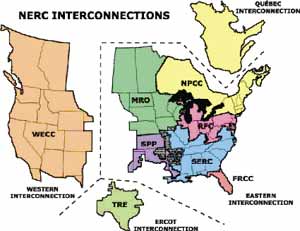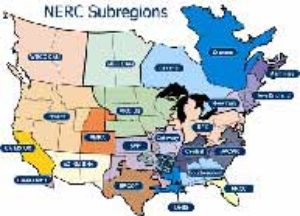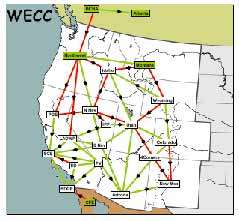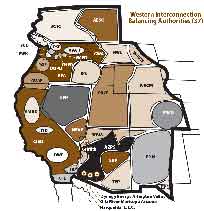U.S. Bulk Transmission System
The U.S. bulk transmission system is a complex network of independently owned and operated power plants and transmission lines. Extra-high-voltage connections between individual utilities permit the transfer of electrical energy from one part of the network to another. This system, also referred to as the power grid, has evolved into three large interconnected systems that move electricity around the country. The three networks are:
- the Eastern Interconnected System (from the Atlantic ocean to the Rocky Mountain States),
- the Western Interconnected System (for States west of the Rocky Mountains), and
- the Texas Interconnected System.These three interconnections fall under the authority of the National Energy Regulatory Commission (NERC), an independent organization whose mission is to ensure the reliability of the bulk power system in North America.
 NERC’s eight regional entities cover the 48 contiguous States and portions of Canada and Mexico.
NERC’s eight regional entities cover the 48 contiguous States and portions of Canada and Mexico.
The Western Interconnection is the geographic area containing the synchronously operated electric grid in the western part of North America, which includes parts of Montana, Nebraska, New Mexico, South Dakota, Texas, Wyoming and Mexico and all of Arizona, California, Colorado, Idaho, Nevada, Oregon, Utah, Washington and the Canadian provinces of British Columbia and Alberta.
The Western Electricity Coordinating Council (WECC)
Formed in 2002 by the merger of the Western Systems Coordinating Council (WSCC) and two regional transmission associations, WECC encompasses the entire Western Interconnection and covers more than 1.8 million square miles. WECC’s members, representing all segments of the electric industry within the Western Interconnection, provide electricity to 71 million people in 14 western states, two Canadian provinces, and portions of one Mexican state.
WECC’s predecessor organization, WSCC, was organized in 1967 to facilitate electric industry coordination in the planning and operations of the electric system in Western North America. Similarly, WECC’s mission today is to:
- maintain a reliable bulk electric power system in the Western Interconnection that supports efficient competitive power markets,
- assure open and non discriminatory transmission access among Members, and
- provide a forum for resolving transmission access disputes between Members consistent with FERC policies.
WECC Reporting Areas:
 Northwest Power Pool Area (NWPP)
Northwest Power Pool Area (NWPP)
Rocky Mountain Power Area (RMPA)
Arizona-New Mexico-Southern Nevada Power Area (AZ/NM/SNV)
California-Mexico Power Area (CA/MX)
Data gathered from the four different Reporting Areas (or NERC Subregions as shown) allows WECC to carry out the mission and perform four organization roles:
- Regional Entity- WECC is required by FERC to monitor and enforce compliance with reliability standards by users, owners and operators of the bulk power system in the United States.
- Credible Source of Interconnection-Wide Information- WECC provides training, education and information on key functions related to mandatory standards and compliance, as well as data, analysis and studies relating to transmission system planning, and renewable integration. WECC is a conduit for other data exchanges.
- Western Interconnection-Wide Planning Facilitator- WECC provides planning functions (transmission planning and integration of resources) and policy-related functions as requested by members.
- Western Interconnection-Wide Regional Reliability Policy Facilitator-WECC facilitates the identification of issues specific to reliability, creates an opportunity for discussion of the issues, and represents region-wide issues and policies at the state and federal levels.
Power Flows Within the WECC
Due to the vastness and diverse characteristics of the region, WECC’s members are faced with unique and challenging problems in coordinating day-to-day interconnected system operation and t
he long-range planning needed to provide reliable and affordable electric service.
Power Supply Adequacy – Consistent with the requirement to maintain operating reserves as defined by WECC and NERC operating policies, WECC conducts, on a seasonal basis, an assessment of generating reserve margins and transmission limitations between load and resource areas as well as probabilities of supplying expected load levels, accounting for uncertainties.
A Balancing Authority (BA), or Control Area, generally comprised of large and small transmission owners, is the responsible entity that matches loads to resources within the system, maintains scheduled interchange between control areas, maintains frequency within reasonable limits, and provides sufficient generation capacity to maintain operating reserves. Load and resource data submitted by the BA to WECC is used to identify areas that have the potential for electricity supply shortages.
Total Existing and Planned Generation – Because temperature and seasonal events can radically influence the generation of power and the need and use of resources, various scenarios are assessed. The scenarios are divided into Classes to determine existing generation, fluctuations in generation and demand, the status and effect of planned generation additions, and the status and effect of planned transmission projects.
The map below provides an example of a power flow scenario in the WECC area.
 Key:
Key:
Red zone – less than 15% reserve margin
Green zone – more than 15% reserve margin
White zone – exactly 15% reserve margin
Red line – path fully loaded in the direction of the arrow
Green line – path partially loaded in the direction of the arrow
Green line with no arrow – path with no flow
Source: WECC Regional Planning Project Review, Loads and Resources Working Group, Demand Analysis of 2015 Scenarios To Explore the Range of Need for a Canada/Pacific Northwest to Northern California Line-October 2007

